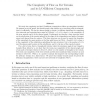Free Online Productivity Tools
i2Speak
i2Symbol
i2OCR
iTex2Img
iWeb2Print
iWeb2Shot
i2Type
iPdf2Split
iPdf2Merge
i2Bopomofo
i2Arabic
i2Style
i2Image
i2PDF
iLatex2Rtf
Sci2ools
COMGEO
2010
ACM
2010
ACM
The complexity of flow on fat terrains and its i/o-efficient computation
We study the complexity and the I/O-efficient computation of flow on triangulated terrains. We present an acyclic graph, the descent graph, that enables us to trace flow paths in triangulations i/o-efficiently. We use the descent graph to obtain i/o-efficient algorithms for computing river networks and watershed-area maps in O(Sort(d + r)) i/o's, where r is the complexity of the river network and d of the descent graph. Furthermore we describe a data structure based on the subdivision of the terrain induced by the edges of the triangulation and paths of steepest ascent and descent from its vertices. This data structure can be used to report the boundary of the watershed of a query point q or the flow path from q in O(l(s) + Scan(k)) i/o's, where s is the complexity of the subdivision underlying the data structure, l(s) is the number of i/o's used for planar point location in this subdivision, and k is the size of the reported output. On -fat terrains, that is, triangula...
| Added | 09 Dec 2010 |
| Updated | 09 Dec 2010 |
| Type | Journal |
| Year | 2010 |
| Where | COMGEO |
| Authors | Mark de Berg, Otfried Cheong, Herman J. Haverkort, Jung Gun Lim, Laura Toma |
Comments (0)

